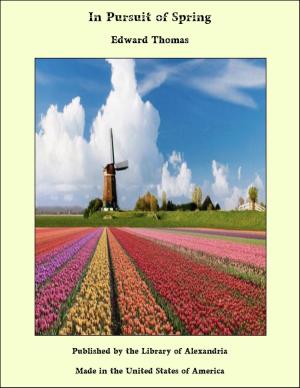| Author: | Arthur Mangin | ISBN: | 9781465628435 |
| Publisher: | Library of Alexandria | Publication: | March 8, 2015 |
| Imprint: | Language: | English |
| Author: | Arthur Mangin |
| ISBN: | 9781465628435 |
| Publisher: | Library of Alexandria |
| Publication: | March 8, 2015 |
| Imprint: | |
| Language: | English |
The area of our present work would be very limited if we understood the word Desert in its more rigorous signification; for we should then have only to consider those desolate wildernesses which an inclement sky and a sterile soil seem to exclude for ever from man’s dominion. But, by a license which usage authorizes, we are able to attribute to this term a much more extended sense; and to call Deserts not only the sandy seas of Africa and Asia, the icy wastes of the Poles, and the inaccessible crests of the great mountain-chains; but all the regions where man has not planted his regular communities or permanent abodes; where earth has never been appropriated, tilled, and subjected to cultivation; where Nature has maintained her inviolability against the encroachments of human industry. Thus understood, the picture we are about to trace assumes not only vast proportions, but an infinite variety of aspects. Here and there, it is true, our eyes will rest on the gloomy spectacle of rugged solitudes, where the soil churlishly refuses almost every kind of product, where the boldest traveller cannot penetrate without a shudder, and where the very beast of prey is rather a visitor than an inhabitant: lugubrious regions, on whose threshold one might write the legend written, according to Dante, on the gates of hell—“Lasciate ogni speranza, voi ch’entrate.” (All hope abandon, ye who enter here.) But, on the whole, these true Deserts offer ample material for the admiration of the artist, the meditations of the thinker, the researches of the naturalist and the physician. Theirs is that kind of beauty which borders on the sublime, and which impresses us so powerfully in the Ocean. And, like the Ocean, they awake in the soul the feeling of infinity. They render it forgetful of the tumultuous regions which are perturbed by petty passions, and vexed by the contentions of ephemeral interests, and transport it to the boundless space and the eternal spheres, or allow it to draw back within itself and muse upon its future destiny. Finally, what grave problems does the Desert place before the man of science! And first, why do life and fertility prevail elsewhere,—here, sterility and death? Why does an irrevocable curse seem to weigh upon certain parts of the world, while others rejoice in Nature’s fairest gifts? It is by examining the constitution of the soil and the character of the climate that we discover the key to this enigma, and recognize in this apparent anomaly a necessary effect of the harmonious laws of the universe. Then the Desert has a geology and a meteorology of its own; is the theatre of special phenomena, which we do not observe in more favoured regions. Life itself is not completely absent from it; specimens of the organic kingdoms are rare, no doubt, but for this very reason are the more interesting. And if, from the Desert properly so called, we pass to those countries where the genial air and the abundant waters favour the action of the productive forces, the interest increases with the increasing development of life. The picture changes every moment, and every moment grows more animated. The scenes of the savage world unfold before our eyes like a moving panorama; unexpected incidents and dramatic episodes multiply one upon another. Every region appears before us with its primitive aspect, its grand and picturesque landscapes, its characteristic fauna and flora—frequently, also, with its tribes of white, or tawny, or black, or copper-coloured men, whose singular manners, brutal instincts, fierce passions, and wretched condition offer, in all its mournful reality, the spectacle of that “state of nature” celebrated by a great writer as the ideal of virtue and happiness.
The area of our present work would be very limited if we understood the word Desert in its more rigorous signification; for we should then have only to consider those desolate wildernesses which an inclement sky and a sterile soil seem to exclude for ever from man’s dominion. But, by a license which usage authorizes, we are able to attribute to this term a much more extended sense; and to call Deserts not only the sandy seas of Africa and Asia, the icy wastes of the Poles, and the inaccessible crests of the great mountain-chains; but all the regions where man has not planted his regular communities or permanent abodes; where earth has never been appropriated, tilled, and subjected to cultivation; where Nature has maintained her inviolability against the encroachments of human industry. Thus understood, the picture we are about to trace assumes not only vast proportions, but an infinite variety of aspects. Here and there, it is true, our eyes will rest on the gloomy spectacle of rugged solitudes, where the soil churlishly refuses almost every kind of product, where the boldest traveller cannot penetrate without a shudder, and where the very beast of prey is rather a visitor than an inhabitant: lugubrious regions, on whose threshold one might write the legend written, according to Dante, on the gates of hell—“Lasciate ogni speranza, voi ch’entrate.” (All hope abandon, ye who enter here.) But, on the whole, these true Deserts offer ample material for the admiration of the artist, the meditations of the thinker, the researches of the naturalist and the physician. Theirs is that kind of beauty which borders on the sublime, and which impresses us so powerfully in the Ocean. And, like the Ocean, they awake in the soul the feeling of infinity. They render it forgetful of the tumultuous regions which are perturbed by petty passions, and vexed by the contentions of ephemeral interests, and transport it to the boundless space and the eternal spheres, or allow it to draw back within itself and muse upon its future destiny. Finally, what grave problems does the Desert place before the man of science! And first, why do life and fertility prevail elsewhere,—here, sterility and death? Why does an irrevocable curse seem to weigh upon certain parts of the world, while others rejoice in Nature’s fairest gifts? It is by examining the constitution of the soil and the character of the climate that we discover the key to this enigma, and recognize in this apparent anomaly a necessary effect of the harmonious laws of the universe. Then the Desert has a geology and a meteorology of its own; is the theatre of special phenomena, which we do not observe in more favoured regions. Life itself is not completely absent from it; specimens of the organic kingdoms are rare, no doubt, but for this very reason are the more interesting. And if, from the Desert properly so called, we pass to those countries where the genial air and the abundant waters favour the action of the productive forces, the interest increases with the increasing development of life. The picture changes every moment, and every moment grows more animated. The scenes of the savage world unfold before our eyes like a moving panorama; unexpected incidents and dramatic episodes multiply one upon another. Every region appears before us with its primitive aspect, its grand and picturesque landscapes, its characteristic fauna and flora—frequently, also, with its tribes of white, or tawny, or black, or copper-coloured men, whose singular manners, brutal instincts, fierce passions, and wretched condition offer, in all its mournful reality, the spectacle of that “state of nature” celebrated by a great writer as the ideal of virtue and happiness.















